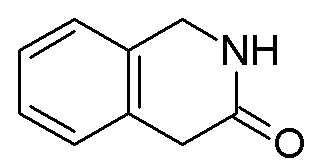1,4-Dihydro-3(2H)-isoquinolinone is widely utilized in research focused on:
- Pharmaceutical Development: This compound serves as a key intermediate in the synthesis of various pharmaceuticals, particularly in the development of analgesics and anti-inflammatory drugs.
- Neuroscience Research: It is used in studies investigating neuroprotective effects, potentially aiding in the treatment of neurodegenerative diseases.
- Organic Synthesis: The compound acts as a versatile building block in organic chemistry, facilitating the creation of complex molecules in drug discovery.
- Biochemical Applications: It is employed in the design of enzyme inhibitors, contributing to advancements in biochemistry and molecular biology.
- Material Science: Researchers explore its properties for developing new materials, including polymers and coatings, enhancing performance in various applications.
General Information
Properties
Safety and Regulations
Applications
1,4-Dihydro-3(2H)-isoquinolinone is widely utilized in research focused on:
- Pharmaceutical Development: This compound serves as a key intermediate in the synthesis of various pharmaceuticals, particularly in the development of analgesics and anti-inflammatory drugs.
- Neuroscience Research: It is used in studies investigating neuroprotective effects, potentially aiding in the treatment of neurodegenerative diseases.
- Organic Synthesis: The compound acts as a versatile building block in organic chemistry, facilitating the creation of complex molecules in drug discovery.
- Biochemical Applications: It is employed in the design of enzyme inhibitors, contributing to advancements in biochemistry and molecular biology.
- Material Science: Researchers explore its properties for developing new materials, including polymers and coatings, enhancing performance in various applications.
Documents
Safety Data Sheets (SDS)
The SDS provides comprehensive safety information on handling, storage, and disposal of the product.
Product Specification (PS)
The PS provides a comprehensive breakdown of the product’s properties, including chemical composition, physical state, purity, and storage requirements. It also details acceptable quality ranges and the product's intended applications.
Certificates of Analysis (COA)
Search for Certificates of Analysis (COA) by entering the products Lot Number. Lot and Batch Numbers can be found on a product’s label following the words ‘Lot’ or ‘Batch’.
*Catalog Number
*Lot Number
Certificates Of Origin (COO)
This COO confirms the country where the product was manufactured, and also details the materials and components used in it and whether it is derived from natural, synthetic, or other specific sources. This certificate may be required for customs, trade, and regulatory compliance.
*Catalog Number
*Lot Number
Safety Data Sheets (SDS)
The SDS provides comprehensive safety information on handling, storage, and disposal of the product.
DownloadProduct Specification (PS)
The PS provides a comprehensive breakdown of the product’s properties, including chemical composition, physical state, purity, and storage requirements. It also details acceptable quality ranges and the product's intended applications.
DownloadCertificates of Analysis (COA)
Search for Certificates of Analysis (COA) by entering the products Lot Number. Lot and Batch Numbers can be found on a product’s label following the words ‘Lot’ or ‘Batch’.
*Catalog Number
*Lot Number
Certificates Of Origin (COO)
This COO confirms the country where the product was manufactured, and also details the materials and components used in it and whether it is derived from natural, synthetic, or other specific sources. This certificate may be required for customs, trade, and regulatory compliance.


